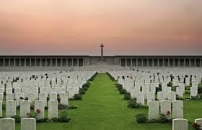| First Name: | Lewis George | Last Name: | COPPARD | |
|---|---|---|---|---|
| Date of Death: | 02/04/1918 | Lived/Born In: | Neasden | |
| Rank: | Rifleman | Unit: | King's Royal Rifle Corps11 | |
| Memorial Site: | Pozieres Memorial, France | |||
Current Information:Born-Suffolk
With an end to the fighting on the Eastern Front after the Russian Revolution, Germany was able to bring its troops from there to France and launch a series of offensives in the Spring of 1918, designed to bring the war to a swift conclusion. Four times between March and July they attacked in strength and on each occasion they broke through the British and French lines and made spectacular gains but in each case they over extended themselves and without adequate supplies keeping up with their rapid advances, they could go no further. The first of these attacks, Operation Michael, was made on 21st March by 63 specially trained divisions, attacking along a 60 mile front held by 26 British divisions, many of them in a weakened state At 4.40am the German artillery opened up with the most ferocious and concentrated bombardment of the war, the likes of which the British had never experienced before. The Forward Zone, consisting mainly of individual posts was blown away. Very few of the men there made it back. Many were killed and many more were taken prisoner. The Battle Zone was also battered as were the British guns, firing from positions just to the rear. Brigade and Divisional HQs were targeted as well and then, from out of the thick mist came the German storm troopers. Moving fast, they skirted round the few remaining strongholds and penetrated deep into the British lines, including those of the Battle Zone, causing the utmost confusion. There were many cases of heroic stands being made but the relentless pressure forced the British back everywhere and there then began a general retreat that went on for two weeks and which ceded to the Germans a huge amount of territory, including all of that that had been won at such great cost during the Battle of the Somme in 1916. 20th Division were not in the front line when the Germans attacked on 21st March. They had moved south from Ypres to the southern part of the Somme front near St Quentin in February and were in XVIII Corps reserve that day with orders to move forward to man the rear zone defences between the Somme and the Omignon from St Simon to Trefcon. On 21st March, the 11th King’s Royal Rifle Corps of 59 Brigade moved by lorry to Foreste to cover troops in the Rear Zone with one company going to Germaine to take up a defensive position there. Over the next two days, along with the other units of 20th Division, 11th King’s Royal Rifle Corps covered the retirement of the rest of the Corps and during the night of 22nd/23rd March fell back behind the River Somme, fighting all the way. Here they took up a position at Voyennes which they held for two days. 24th March was a day of heavy fighting as the enemy pressed hard but after most of the Battalion HQ personnel, including the commanding officer, were killed by shell fire, they retired, under heavy artillery and machine-gun fire to the line of the Libermont canal near Languevoisin. The following day there were heavy attacks from the north and the battalion was nearly cut off when Nesle was captured by the enemy. That evening they withdrew, fighting all the way, to the line Cressy-Billancourt-Rethonvillers and overnight fell back further to Roye. A further move on 26th March took the division back to the Le Quesnel area and at noon on the following day 11th King’s Royal Rifle Corps moved up in front of Folies and beat off a frontal attack. By now all the units of 20th Division were disorganised, fragmented and scatterered but some semblance of order was maintained and on the evening of 28th March they took up a position behind wire, from Démuin to Mézières-en-Santerre with 61 Brigade in front. There was heavy fighting here the next day. Mézières-en-Santerre was lost, retaken and then lost again but German advances to the north resulted in a further withdrawal to a line just in front of the Moreuil-Démuin road. On 30th March there were repeated attacks along the whole of the Corps front. 20th Division fell back some distance but at 7pm, a counter attacked regained all the original line. This however was a short lived success. On 31st March attacks on both sides of 20th Division forced them back to the River Luce and on 1st April they were holding a series of bridgehead positions here, with their left resting on Hangard. That evening they were withdrawn to the Quevauvillers area and after ten days of moving and fighting 11th King’s Royal Rifle Corps were out of the battle having sustained over 400 casualties, either killed, wounded or missing. In the confusion of battle and retreat it was nigh on impossible to keep up with all these losses and it was only on 2nd April, a day when there were no casualties in the battalion, that many of the deaths were officially recorded, including that of Lewis Coppard, whereas in reality he was almost definitely killed on some day between 22nd and 31st March. |
||||
| « Back to Search Results | ||||
| If you think any of the information shown here is incorrect, Click Here to submit your amends and comments | ||||




